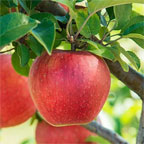- Q.Will The Use Of Inoculant Help Other Plants In My Veg Garden Such As Melons - Does inoculant help plants other than peas and beans?
- Q.Quay (spelling?) Has Anyone But Me Ever Heard Of It? - I am trying to find information on a vegetable my aunt grew 30 years or more ago. I know it ...
- Q.Melons - I have two melons I bought from a garden center and four that I grew from seed. One from the ...
- Q.How To Cut Melon Branch - How do you cut the melon branch? When and how?
- Q.Growing Melons In Northern Climates - I found watermelon and muskmelon plants at my local garden centre this year and very excitedly brought them home and ...
- Q.Personal Melons - We are growing what is called personal melons. They are dark green in color with a light spot on the ...
- Q.Muskmelon Harvest - I have several musk melons and they are not ripe yet. Is there a way to pick and store them ...
Q.Will the Use of Inoculant Help Other Plants in My Veg Garden Such as Melons
Does inoculant help plants other than peas and beans?
- A.
No, the inoculant helps the roots of legums take up nitrogen. As other plants do not have this ability, it does not help them.
Was this answer useful?00
Q.Quay (spelling?) has anyone but me ever heard of it?
I am trying to find information on a vegetable my aunt grew 30 years or more ago. I know it only by the name quay. That may not be how it is spelled. It looks like a cross between a cucumber and a squash--long, round, the outside is ribbed, and green. The inside looks similar to a cucumber. No one outside my family has ever heard of it, and the generation who grew it is gone. All of us kids, now adults, only know it by the name quay, not sure of the spelling. We want to grow some but have been unsuccessful in finding anything about it. My aunt lived and grew it for many years in Midland, Texas. Thanks in advance for any help you might can provide.
- A.
Sounds a little like bitter melon. Here is a picture: http://www.flickr.com/photos/gariwerd/505268166/
There is a chinese vegetable called a Mo Qua. It does not quite fit teh description of what you are looking for, but might be related: http://chinesefood.about.com/od/vegetablesrecipes/ig/Chinese-Vegetables-Pictures/Fuzzy_Melon_Photo.htm
Was this answer useful?00 Q.Melons
I have two melons I bought from a garden center and four that I grew from seed. One from the garden center died, but the other has two flowers on it. The others are doing quite well, I think. I have them in the greenhouse in large pots. The problem I have is that I don't know what flower is the male and which is the female in order to try and pollinate them. Also, I have been told to feed them with tea oil or fish oil, which I have never even heard of and don't know where to get them from. Should I put the melons outside? Would that be best? How high should they grow, etc. ?
- A.
This article will help with growing melons: https://www.gardeningknowhow.com/edible/fruits/melons/growing-melons.htm
https://www.gardeningknowhow.com/edible/fruits/melons/hand-pollinating-melons.htmWas this answer useful?00 Q.How To Cut Melon Branch
How do you cut the melon branch? When and how?
- A.
These articles should help: https://www.gardeningknowhow.com/edible/fruits/watermelon/pick-a-watermelon.htm
https://www.gardeningknowhow.com/edible/fruits/cantaloupe/harvesting-cantaloupe.htmWas this answer useful?00 Q.Growing Melons In Northern Climates
I found watermelon and muskmelon plants at my local garden centre this year and very excitedly brought them home and planted them once we were frost free. Unfortunately, they aren't doing very well; their leaves aren't perky, and honestly, they look a little sickly. I planted them a little more than a week ago, so I figured they'd be getting better established by now, but I don't see any growth. I have both melons planted in their own hills away from my squashes, and rounded out a small 'lake' spot on top of the mounds to encourage the water to go deeper. I let them dry out just a little between waterings. I don't have a compost bin yet, but will for next year. Any suggestions on how to get them flourishing?
- A.
This article may help: https://www.gardeningknowhow.com/edible/fruits/melons/growing-melons.htm
Was this answer useful?00 Q.Personal Melons
We are growing what is called personal melons. They are dark green in color with a light spot on the dirt side. The leaves are still dark green but a hollow sound when they're thumped. I opened one about a month ago and it was still white inside. Do I still have to wait until the leaves turn color or is this certain type of melon different?
- A.
If we are talking about the same thing, personal melons are simply small watermelons that grow small to make it easier for a family to use up. So you will want to follow the same directions for these melons as you would with watermelons. Not only do they need to sound hollow, but the light spot needs to turn yellow before it is ripe. Here is more information: https://www.gardeningknowhow.com/edible/fruits/watermelon/pick-a-watermelon.htm
Was this answer useful?00 Q.muskmelon harvest
I have several musk melons and they are not ripe yet. Is there a way to pick and store them to enjoy later on? Will a frost hurt the melon itself?
- A.
The melons will soften once picked, but will not get any sweeter if picked to early. For this reason, it is best to leave them on the vine as much as you can until as close to ripe as possible. If you must pick them before ripe, you can place them in a paper bag and in a few days they will be soft enough to eat, though you may find they are not as sweet as they could be.
The fruit can take a light frost, but should be picked after any frost has touched the plant.
Was this answer useful?00



